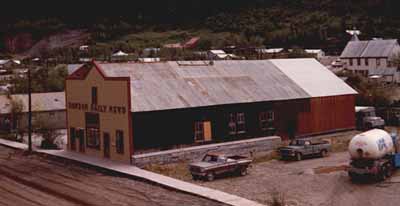Dawson Daily News
Recognized Federal Heritage Building
Dawson, Yukon Territory

General view
© Parks Canada Agency / Agence Parcs Canada, J. Mattie, 1988.
Address :
123 3rd Avenue, Dawson Historical Complex National Historic Site of Canada, Dawson, Yukon Territory
Recognition Statute:
Treasury Board Policy on Management of Real Property
Designation Date:
1989-02-02
Dates:
-
1901 to 1901
(Construction)
Custodian:
Parks Canada
FHBRO Report Reference:
88-012
DFRP Number:
20012 00
Description of Historic Place
The Dawson Daily News is located in the historic district of Dawson. The rectangular, gable roofed timber structure has an asymmetrical, Boomtown fronted, street elevation with ‘Dawson Daily News’ painted across it in large letters. The designation is confined to the footprint of the building.
Heritage Value
The Dawson Daily News is a Recognized Federal Heritage Building because of its historical associations, and its architectural and environmental values.
Historical Value
The Dawson Daily News is one of the best examples of a structure illustrating the development of journalism in northern Canada. The building housed one of 12 newspapers in publication in Dawson following the Klondike Gold Rush, the Dawson Daily News, which proved to be a viable newspaper lasting from 1899 to 1954. Two individuals closely associated with the plant, first as linotype operators and then as proprietors, were Harold Malstrom and Helmer Samuelson. Both men struggled to maintain this Dawson City newspaper.
Architectural Value
The Dawson Daily News is an example of a warehouse structure of the Gold Rush period from 1897-1906. Its good functional design is evidenced in its successful adaptation into a publishing, printing and jobbing business.
Environmental Value
The Dawson Daily News maintains an unchanged relationship to its site, reinforces the historic character of Dawson, and is a familiar landmark to residents and visitors.
Sources: Dawson News Publishing Plant, 995 Second Avenue, Dawson City, Yukon, Federal Heritage Buildings Review Office Report notes 88-012; Dawson News Publishing Plant, Queen Street, Southwest Corner Second Avenue, Dawson City, Yukon Territory, Heritage Character Statement 88-012.
Character-Defining Elements
The following character-defining elements of the Dawson Daily News should be respected.
Its good functional design and good quality materials and craftsmanship, for example: the rectangular massing; the gable roof supported by Queen rod trusses; the asymmetrical, boomtown-fronted street elevation with ‘Dawson Daily News’ painted across it in large letters; the operable windows and large doors; the timber construction.
The manner in which the Dawson Daily News maintains an unchanged relationship to its site, reinforces the historic character of its streetscape setting and is a familiar landmark, as evidenced by: its ongoing historic relationship to the lot lines, the boardwalk, the adjacent structures and the streetscape of Queen Street; its materials, the detailing, and the treatment of the façades, which visually unify the building to the rest of Dawson’s buildings; its visibility due to its location on an open lot and signage which make it familiar to residents of Dawson and to visitors.
Heritage Character Statement
Disclaimer -
The heritage character statement was developed by FHBRO to explain the reasons for the designation of a federal heritage building and what it is about the building that makes it significant (the heritage character). It is a key reference document for anyone involved in planning interventions to federal heritage buildings and is used by FHBRO in their review of interventions.
The plant of the Dawson News Publishing Co. was constructed in late summer 1901 as a warehouse for Barrett and Hull, commission merchants. The architect is unknown. Purchased by the News in March, 1910, the building was extensively modified to accommodate their publishing, printing and jobbing business. The rear one-quarter of the building, destroyed in a 1940 fire, was reconstructed to its original pattern, in 1985-1986. The plant is now the property of the Canadian Parks Service, Environment Canada. See FHBRO Building Report 88-12.
Reasons for Designation
The News plant was designated Recognized because of the important historical theme with which it is associated, the associations it had with important individuals, the integrity of its historic environment and the symbolic importance it has within the community.
The News plant is closely associated with "journalism in the North." Of the more than 12 newspapers which sprang up in Dawson following the rush, the News was the most durable representative, extending from 1899 to 1954. Two individuals closely associated with the News plant first as Linotype operators and later as proprietors, are Harold Malstrom and Helmer Samuelson. Both are somewhat tragic figures, who fought against the odds to maintain Dawson's newspaper. In its present, partially restored state the plant presents essentially the same appearance in the Dawson City streetscape as it did in 1910. To the Dawson citizenry and the majority of visitors who can hardly miss the painted sign on its false front, the News plant is a conspicuous landmark.
Character Defining Elements
The heritage character of the building derives from the asymmetrical false-
fronted street elevation determined by its warehouse origins, and adapted to suit its later newspaper office use. Those elements belonging to its 10 years as a warehouse; i.e. the outline of the facade, the operable windows, the "Stanley Scearce" sign (preserved beneath a number of paint layers) and the stub pieces of a wood framed awning deserve preservation. The changes brought about by the conversion to a newspaper office; i.e. the set of front doors, reworked central window and "Dawson Daily News" sign equally deserve preservation.
Internally, many of the architectural elements, mechanical/electrical/heating equipment,
built-in furnishings and machinery associated with the building's use as a newspaper
building office survive. In the context of industrial archaeology the Dawson Daily News is a unique document. Those elements in the attic which bear witness to the near fatal fire of 1940; i.e. the charred Queen rod trusses and architectural fabric, should be preserved. The building should only be used for functions which will not jeopardize evidence of its pre-1924 industrial past.